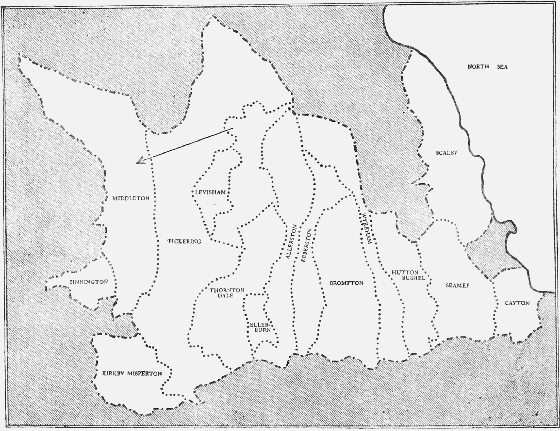A History of the County of York North Riding: Volume 2. Originally published by Victoria County History, London, 1923.
This free content was digitised by double rekeying. All rights reserved.
'The wapentake of Pickering Lythe', in A History of the County of York North Riding: Volume 2, ed. William Page (London, 1923), British History Online https://prod.british-history.ac.uk/vch/yorks/north/vol2/pp418-420 [accessed 19 April 2025].
'The wapentake of Pickering Lythe', in A History of the County of York North Riding: Volume 2. Edited by William Page (London, 1923), British History Online, accessed April 19, 2025, https://prod.british-history.ac.uk/vch/yorks/north/vol2/pp418-420.
"The wapentake of Pickering Lythe". A History of the County of York North Riding: Volume 2. Ed. William Page (London, 1923), British History Online. Web. 19 April 2025. https://prod.british-history.ac.uk/vch/yorks/north/vol2/pp418-420.
THE WAPENTAKE OF PICKERING LYTHE
containing the parishes of Allerston; Brompton; Cayton; Ebberston; Ellerburn; Hutton Bushel; Kirkby Misperton; Levisham; Middleton; Pickering; Scalby; Seamer; Sinnington; Thornton Dale; Wykeham

Index Map to the Wapentake of Pickering Lythe
This wapentake is found in the Domesday Survey under the name of 'Dic,' (fn. 1) which probably originated from the meeting-place of the wapentake at one of the numerous dykes in this district. Whether this wapentake had any connexion with the adjoining 12th-century wapentake of Dickering, which comprised the Domesday hundreds of Turbar, Hunton and Burton in the East Riding, is uncertain, but it is significant that the Deanery of Dickering, according to the Valor of 1535, included approximately the wapentake of Dickering and the eastern ward of the wapentake of Dic or Pickering. There is no further reference to the wapentake of Dic (fn. 2) after the Domesday Survey, and in 1165–6 the name of the wapentake of Pickering is found. (fn. 3) In 1201 (fn. 4) King John confirmed to the monks of Rievaulx pasture within such bounds as had been sworn to by the 'wapentake of Pickering Lythe' (fn. 5) in the time of Henry II; the 'wapentake of Pickering' is, however, the form more usually employed in the 13th century. (fn. 6)
The wapentake of Dic seems to have been divided into two portions corresponding for the most part with the later east and west wards of the forest of Pickering, wards which in their turn appear to correspond with the respective sokes of the royal 'manors' of Falsgrave and Pickering. In 1086 part of the soke of the 'manor' of Falsgrave lay in Filey and Gristhorpe; this was, perhaps, in what was afterwards Lebberston and Gristhorpe, for both these townships of Filey parish have remained in this wapentake, while Filey itself as early as 1284–5 (fn. 7) was in the East Riding and wapentake of Dickering. Falsgrave probably included Scarborough in 1086, and the town and castle of Scarborough were 'within the boundes of Pickeringlith but freed from the same by charter.' (fn. 8) Hackness, also soke of Falsgrave, became a member of the Liberty of Whitby Strand.
All the west ward of Pickering Lythe Wapentake was in the wapentake of Dic except the south-west corner towards Holme Bridge. Here, however, both Kirkby Misperton and Sinnington were in Maneshou, afterwards Ryedale Wapentake, in 1086, while Lastingham, afterwards in Ryedale, was in Dic. (fn. 9) By 1301 the wapentake of Pickering Lythe was formed of its present constituents with the exception of the townships of the parish of Kirkby Misperton. (fn. 10) The townships of Great and Little Habton, Barughs Ambo and Ryton were in the wapentake of Ryedale, (fn. 11) while Kirkby Misperton was in the Liberty of St. Mary's Abbey, (fn. 12) York. Kirkby Misperton, however, was within the honour and the whole parish within the forest of Pickering, (fn. 13) and by 1539 it was accounted within the wapentake also. (fn. 14)
King John in 1213 ordered inquiries to be made as to whether the 'hundred' belonged to the castle and confirmed the existing custom. (fn. 15) The wapentake has ever since been appurtenant to the castle, with which it was granted to Edmund of Lancaster.
Full regalian rights were enjoyed by the lords of Pickering, who had the return of writs, (fn. 16) the wapentake not answering to the sheriff 'except in those things which pertain to the Crown.' (fn. 17) The liberty extended over Easingwold and Huby, but Staintondale in the parish of Scalby was within the Liberty of the Templars. (fn. 18) The Earls of Lancaster had also estreats, pleas of namii vetiti and wreck of sea. (fn. 19)
In 1276 the priors declared that for the last seven years Agnes de Vescy had refused the king's bailiff entrance to her manor of Brompton (fn. 20); this claim is not mentioned in 1284–5, when it was said that the lords of Seamer, Cropton and Brompton had held courts, taken the amendment of the assize of ale, had gallows and done justice on thieves time out of mind. (fn. 21) In 1622 it was said that a custom began in Sir Henry Gate's time, (fn. 22) with the consent of the majority of the freeholders in Pickering Lythe, that every freeholder holding land of Pickering Castle should pay 4d. yearly instead of doing suit at the wapentake court. (fn. 23) This new custom had become fixed by 1651. (fn. 24)